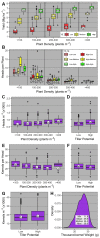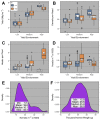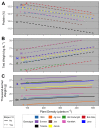Winter Wheat Yield Response to Plant Density as a Function of Yield Environment and Tillering Potential: A Review and Field Studies
- PMID: 32194579
- PMCID: PMC7066254
- DOI: 10.3389/fpls.2020.00054
Winter Wheat Yield Response to Plant Density as a Function of Yield Environment and Tillering Potential: A Review and Field Studies
Abstract
Wheat (Triticum aestivum L.) grain yield response to plant density is inconsistent, and the mechanisms driving this response are unclear. A better understanding of the factors governing this relationship could improve plant density recommendations according to specific environmental and genetics characteristics. Therefore, the aims of this paper were to: i) execute a synthesis-analysis of existing literature related to yield-plant density relationship to provide an indication of the need for different agronomic optimum plant density (AOPD) in different yield environments (YEs), and ii) explore a data set of field research studies conducted in Kansas (USA) on yield response to plant density to determine the AOPD at different YEs, evaluate the effect of tillering potential (TP) on the AOPD, and explain changes in AOPD via variations in wheat yield components. Major findings of this study are: i) the synthesis-analysis portrayed new insights of differences in AOPD at varying YEs, reducing the AOPD as the attainable yield increases (with AOPD moving from 397 pl m-2 for the low YE to 191 pl m-2 for the high YE); ii) the field dataset confirmed the trend observed in the synthesis-analysis but expanded on the physiological mechanisms underpinning the yield response to plant density for wheat, mainly highlighting the following points: a) high TP reduces the AOPD mainly in high and low YEs, b) at canopy-scale, both final number of heads and kernels per square meter were the main factors improving yield response to plant density under high TP, c) under varying YEs, at per-plant-scale, a compensation between heads per plant and kernels per head was the main factor contributing to yield with different TP.
Keywords: synthesis-analysis; tillering potential; wheat; yield components; yield environment.
Copyright © 2020 Bastos, Carciochi, Lollato, Jaenisch, Rezende, Schwalbert, Vara Prasad, Zhang, Fritz, Foster, Wright, Young, Bradley and Ciampitti.
Figures







References
-
- Anderson W., Barclay J. (1991). Evidence for differences between three wheat cultivars in yield response to plant population. Aust. J. Agric. Res. 42 (5), 701. 10.1071/AR9910701 - DOI
-
- Arduini I., Masoni A., Ercoli L., Mariotti M. (2006). Grain yield, and dry matter and nitrogen accumulation and remobilization in durum wheat as affected by variety and seeding rate. Eur. J. Agron. 25 (4), 309–318. 10.1016/j.eja.2006.06.009 - DOI
-
- Assefa Y., Vara Prasad P. V., Carter P., Hinds M., Bhalla G., et al. (2016). Yield responses to planting density for us modern corn hybrids: a synthesis-analysis. Crop Sci. 56 (5), 2802. 10.2135/cropsci2016.04.0215 - DOI
-
- Assefa Y., Prasad P. V. V., Foster C., Wright Y., Young S., et al. (2018. b). Major management factors determining spring and winter canola yield in North America. Crop Sci. 58 (1), 1. 10.2135/cropsci2017.02.0079 - DOI
LinkOut - more resources
Full Text Sources
Other Literature Sources

